From W 187 to ‘Ponton Mercedes’ (1951 to 1959)
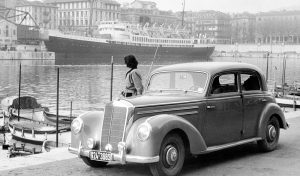
The direct ancestral line of the S-Class begins in the post-war period with the type 220 (W 187) which marked the return of Mercedes-Benz to the luxury segment in 1951 – six years after the end of the Second World War and after the first phase of Germany’s reconstruction was complete. In 1954, this was followed by a completely new model with the same designation. This new type 220, also known internally as the 220 a (W 180), was the first Mercedes-Benz six-cylinder model with a unitized body design. Its ultra-modern, spacious ‘ponton’ body offered previously unheard of levels of comfort. With the launch of the overhauled and more powerful type 220 S in 1956, the ‘S’ designation became a permanent fixture in the names of high-end Mercedes-Benz models, underlining the special status of the ponton six-cylinder. 1958 saw the launch of the 220 SE (W 128), an even more powerful version of the flagship model thanks to fuel injection. As with the 300 d (W 189) luxury limousine introduced one year earlier, the vehicle’s performance and efficiency were enhanced by manifold injection.
Mercedes-Benz 220, W 187 (1951 to 1954)
- Cutting-edge six-cylinder engine with overhead camshaft
- Safety tang lock to prevent the doors from bursting open
- Heating with blower(s) as special equipment
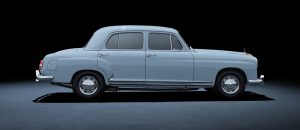
Mercedes-Benz 220 a/220 S/220 SE, W 180/W 128 (1954 to 1959)
- Integral body construction
- Increased spaciousness and comfort due to modern ponton shape
- Front suspension subframe
- Single-joint swing axle with low centre of rotation
- Brake drums with turbo cooler
- Heating with blower(s) as standard, separately adjustable for driver and front passenger
- Hydrak automated hydraulic clutch as special equipment (from 1957)
- Manually-controlled intake manifold fuel injection (220 SE, from 1958
The ‘Adenauer Mercedes’ (1951 to 1962)
After the Second World War, Mercedes-Benz once again dominated the luxury class automotive segment. The type 300 (W 186) made its debut in 1951 along with the type 220 at the first International Motor Show (IAA) in Frankfurt am Main. When it was launched, the new flagship model from Mercedes-Benz was the fastest German production car with a top speed of 160 km/h. The 300 was also the first official state vehicle produced in Germany after the war and therefore represents, like no other model, Germany’s return to the international stage. The German Chancellor Konrad Adenauer was given one of the first examples of this model in December 1951 and, from then on, he would be driven around in nothing other than a type 300. Consequently, the high-end model became popularly known as the ‘Adenauer Mercedes’. The type 300 was completely revised in 1957 and was given the internal designation 300 d (W 189). The ‘d’ stood for the fact that this was the fourth version (after the 300, 300 b, and 300 c). The car’s higher engine output was thanks to fuel injection which, for the first time, was no longer direct fuel injection, but manifold injection. The longer wheelbase and larger body resulted in greater comfort, as did the optional electronic power steering and air conditioning – both of which were anything but commonplace at the time. The air conditioning system, known back then as the ‘cooling system’, was available at an extra cost of DM 3,500 – about the same as it would have cost for an entire VW Beetle at the end of the 1950s.
 Mercedes-Benz 300, W 186 and W 189 (1951 to 1962)
Mercedes-Benz 300, W 186 and W 189 (1951 to 1962)
- Cutting-edge six-cylinder engine with overhead camshaft
- Manually-controlled intake manifold fuel injection (from 1957)
- Safety tang lock to prevent the doors from bursting open
- Electrically-operated torsion bar suspension to compensate the height of the rear wheels under heavy loads
- Heating with blower(s) as standard
- Air conditioning as special equipment (from 1958)
- Power-assisted steering as special equipment (from 1958)
Gallery

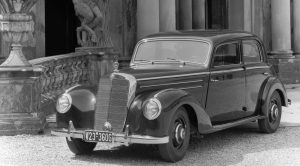
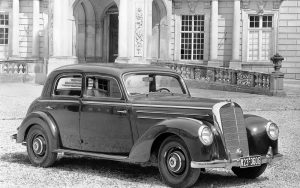

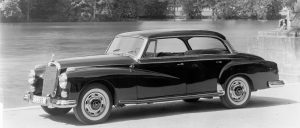


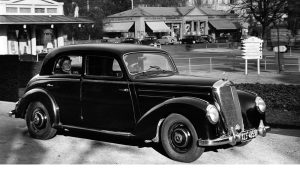


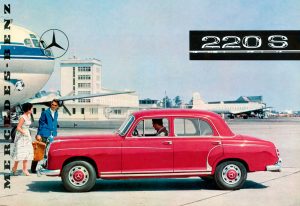
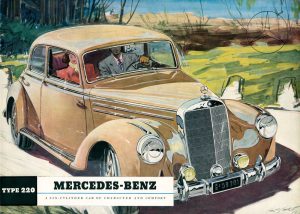

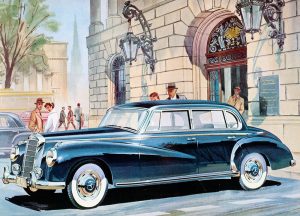
You must be logged in to post a comment.